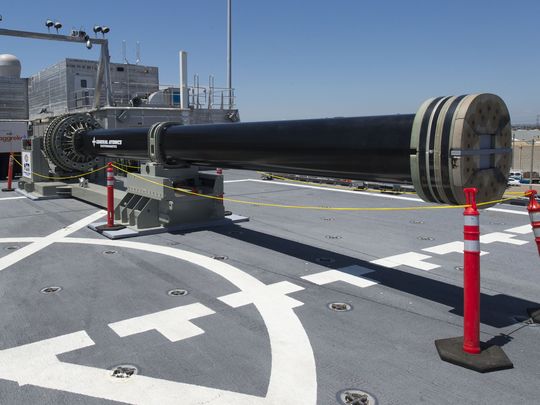scientists expect the railgun rounds to travel at speeds up to Mach 7.5, which at 5,700 mph (9,100 kph) is more than seven times the speed of sound, and cover a distance of about 100 miles (160 kilometers.)
“The railgun is revolutionary in terms of how much it can accelerate the bullet,” Tom Boucher, the railgun program manager for Office of Naval Research, told AFP at the Pentagon as he displayed six interconnected steel plates that all had been shredded by a single test round.
“Powder guns have been matured to the point where you are going to get the most out of them. Railguns are just beginning.”
The railgun, which so far has cost more than $500 million, may find itself becoming something of a victim of its own success — even before it is made operational.
Special railgun shells fired from conventional guns could reduce the urgency of railguns.
High Velocity Projectiles can be guided in flight and can fired from a conventional five-inch cannon.
Though the HVPs would travel slower than they would out of a railgun, they still outperform regular shells, making them a tempting proposition for the Navy to deploy across its fleet.
The enormous forces generated by the HVP leaving the gun caused early versions to fail after only a few shots, but scientists say they are now working toward a solution that could see the barrel last for thousands of rounds.
Boucher said he is optimistic the gun will ultimately end up being operationally deployed, probably within a decade.
Army Chief of Staff General Mark Milley this week said he envisions a time in the not-so-distant future where railguns and lasers are deployed on land.
University of North Carolina physicist Mark Gubrud says the main limitation of the railgun is how much energy per shot you can deliver to the projectile and sabot without destroying the rails too fast. Patrick Tucker at Defense One details the challenges facing railguns using more than 5 megawatts of power per shot.
This is about 5 megajoules, depending on the energy loss. “All that plasma that you see when the gun erupts, that’s material from the rails and sabot being vaporized at the sliding contact”.
SOURCES – Defense News

Brian Wang is a Futurist Thought Leader and a popular Science blogger with 1 million readers per month. His blog Nextbigfuture.com is ranked #1 Science News Blog. It covers many disruptive technology and trends including Space, Robotics, Artificial Intelligence, Medicine, Anti-aging Biotechnology, and Nanotechnology.
Known for identifying cutting edge technologies, he is currently a Co-Founder of a startup and fundraiser for high potential early-stage companies. He is the Head of Research for Allocations for deep technology investments and an Angel Investor at Space Angels.
A frequent speaker at corporations, he has been a TEDx speaker, a Singularity University speaker and guest at numerous interviews for radio and podcasts. He is open to public speaking and advising engagements.


